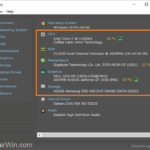If you’re a PC gamer, you know how important it is to have a high-performing system. When it comes to gaming, a slow or unresponsive PC can be frustrating, and it can even impact your gameplay experience. The good news is that there are ways to optimize your PC for better gaming performance, and this article will show you how.
In this guide, we’ll walk you through the steps you can take to optimize your PC for gaming. We’ll cover everything from hardware upgrades to software tweaks, and we’ll give you some tips on how to maintain your system for optimal performance. Whether you’re a seasoned gamer or just getting started, the tips and techniques in this article will help you get the most out of your gaming experience.
Before we dive into the specifics of optimizing your PC for gaming, it’s important to understand why this matters. When you’re gaming, your PC is doing a lot of heavy lifting, from rendering high-quality graphics to processing input from your keyboard and mouse. If your PC isn’t not properly setup, you might experience lag, dropped frames, or other issues that can impact your gameplay. By optimizing your PC for gaming, you can ensure that your system is running at its best, so you can get the most out of your favorite games.
Meet Gaming Hardware Requirements.
Before you start optimizing your PC for gaming, it’s important to know the system requirements for the games you want to play.
System requirements are the technical specifications that your PC needs to meet in order to run a particular game. These specifications can include things like the minimum CPU, RAM and GPU requirements, and the operating system that the game supports. Meeting or exceeding these system requirements is essential for a smooth and enjoyable gaming experience.
Every game has a set of minimum and recommended system requirements, and these requirements can vary widely depending on the game.The system requirements should be listed on the game’s manufacturer support site, in a format like this for example:
OS: Windows 10
Processor: Intel Core i5-6700K or or AMD Ryzen 5 3600
Memory: 8 GB RAM
Graphics: Nvidia GeForce GTX 1650 or AMD Radeon RX6600
Storage: 50 GB of available space.
Once you’ve found the system requirements for your game, you can check your PC’s hardware to see if it meets or exceeds those requirements, by using one of the following free utilities:
- CPU-Z
- Speccy
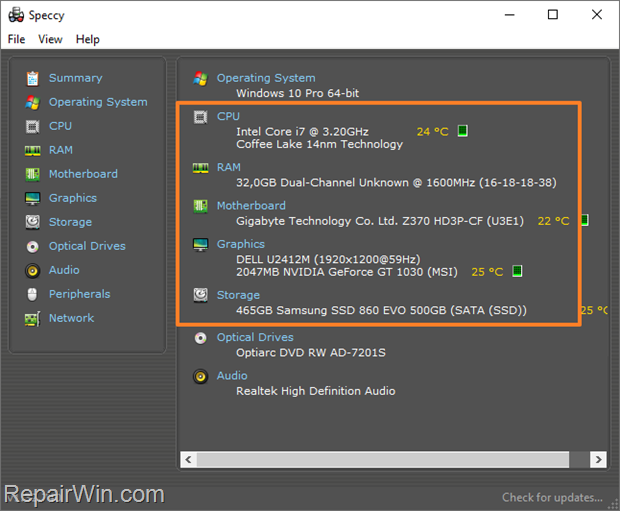

If your PC doesn’t meet the minimum requirements, you may need to upgrade your hardware to run the game. If your PC meets the minimum requirements but not the recommended requirements, you may be able to improve your gaming experience by upgrading your hardware.
In general, it’s a good idea to have hardware that exceeds the recommended system requirements whenever possible. This will ensure you have a smooth and enjoyable gaming experience and also protect your system for new games that may have higher system requirements.
How to Optimize Windows 10/11 for Better Gaming Performance.
There are many things you can do to optimize Windows 10/11 for better gaming performance and they are listed below:
1. Update your Graphics drivers.
The first important step to optimize Windows 10 for a better gaming experience, is to ensure that you have the latest drivers for your graphics card. To do that:
1. Press Windows ![]()
![]() + R keys to open the Run command box.
+ R keys to open the Run command box.
2. Type control appwiz.cpl and press OK (or Enter)


3. In the list of programs, locate the manufacturer or your graphics card (NVIDIA, AMD, Intel), and notice the Graphics Driver version.
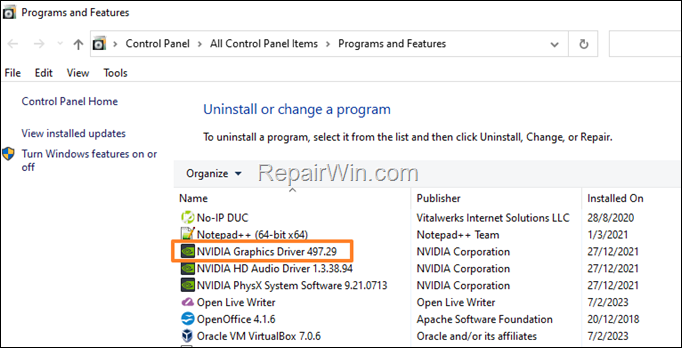

4. Then navigate to manufacturer’s support site and see if there is available a newer driver for your Graphics Card Model. If so, download and install it. *
- NVIDIA drivers
- AMD drivers
- Intel drivers
* Suggestions:
1. Before installing the new Graphics drivers, proceed and uninstall the old one from your PC.
2. If you already have the latest Graphics drivers and you face problems in gaming, try to clean install it again.
2. Set the Windows Power Plan to High Performance.
By adjusting the Windows power settings to “High Performance” you ensure that your computer is using its full power potential. To do that:
1. Press Windows ![]()
![]() + R keys to open the Run command box.
+ R keys to open the Run command box.
2. Type control powercfg.cpl and press OK (or Enter)
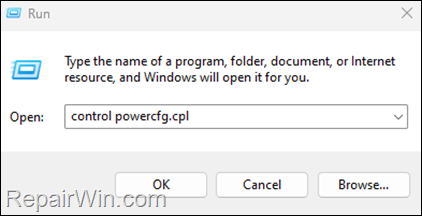

3. In Power Options, select (check) the High Performance. (If you don’t see the High Performance plan, click on drop-down arrow next to “Hide additional plans”).
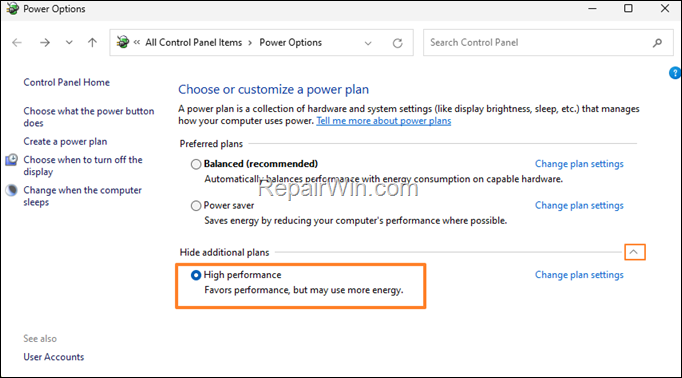

3. Set the GPU Power to Maximum.
Setting the GPU Power to “Maximum Performance” can improve performance in certain applications and games when the GPU is throttling the clock speeds incorrectly resulting in low fps. To do that:
- On NVIDIA Graphics Cards, open the NVIDIA Control Panel and at Manage 3D settings section, set the Power Management mode to Prefer maximum performance and hit Apply > OK.


- On AMD Radeon Graphics Cards, open the AMD Radeon Software and at Performance tab, select Tuning from the sub-menu. Then set Power Tuning to Enabled and adjust the power limit using the Power Limit (%) slider. Click Apply Changes to save the setting. *
* Note: For more instructions on how to optimize your gaming performance with the AMD Radeon Software, read this article: How to Tune GPU Performance Using Radeon Software.
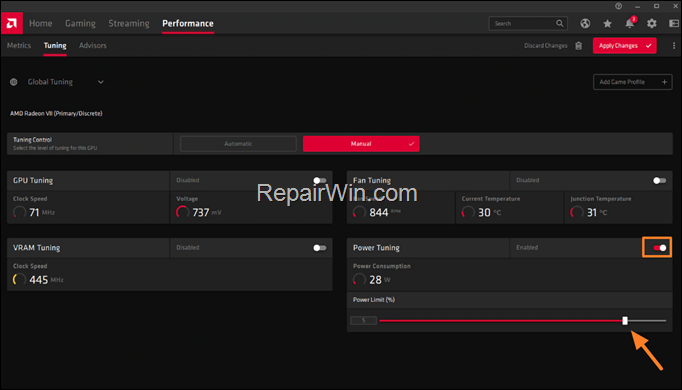

4. Disable Unnecessary Startup programs.
The next step to speed-up your PC, is to close any unnecessary programs and services that might be running in the background and using system resources. In general, try to have as few programs open in the background as possible, by doing the following:
1. Press CTRL + SHIFT + ESC to open the Task Manager.
2. In Startup tab, select and disable any program that don’t needed to run in the background.
3. When done, restart your computer.


5. Adjust Windows for Best Performance.
Disabling certain visual effects in Windows can free up system resources that your games can use and increase your computer’s performance.
1. Press Windows ![]()
![]() + R keys to open the Run command box.
+ R keys to open the Run command box.
2. Type control sysdm.cpl and press OK (or Enter).
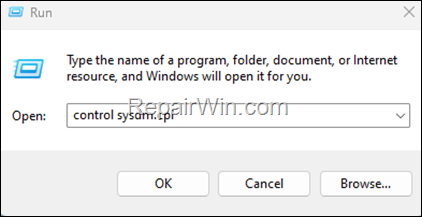

3. In System Properties window, select the Advanced tab and then open the Performance Settings.


4. Select the option Adjust for best performance and hit Apply and OK.


6. Disable Notifications & Background Runnings Apps.
The next step to optimize your computer’s performance is disable the notifications from apps and other senders, and to disable the background apps if you’re running Windows 10.
1. To disable the Notifications, go to Start > Settings > System > Notifications and set the Notifications to Off
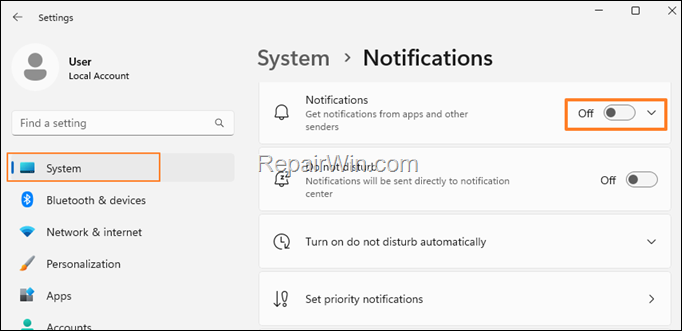

2. To disable the Apps that run in the background on Windows 10, go to Start > Settings > Privacy, select the Background apps under the ‘App permissions’ section and set the Background Apps to Off.
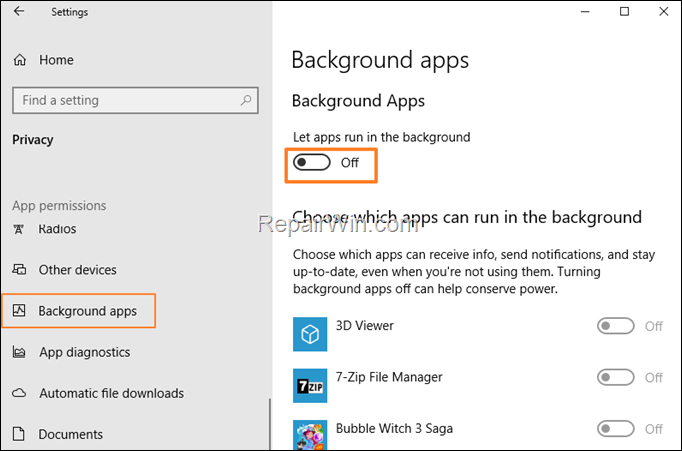

7. Enable Game Mode.
Windows 10 & Windows 11 has a built-in game mode that optimizes your system for gaming. To enable it:
1. Go to Start > Settings > Gaming > Game Mode.
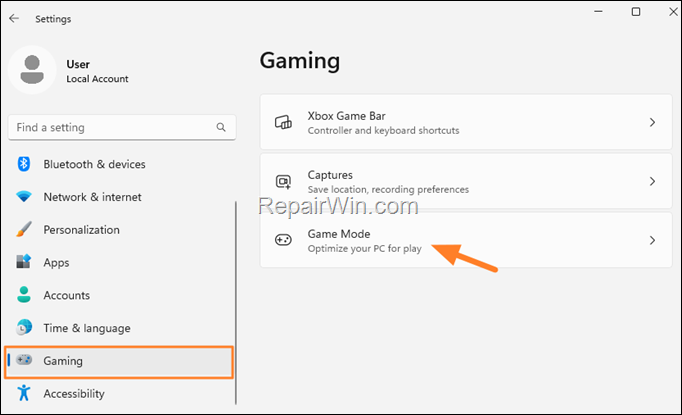

2. Set the Game Mode switch to On and then click on Graphics under the Related settings. *
* Note: If you own Windows 10, click on Graphics settings.
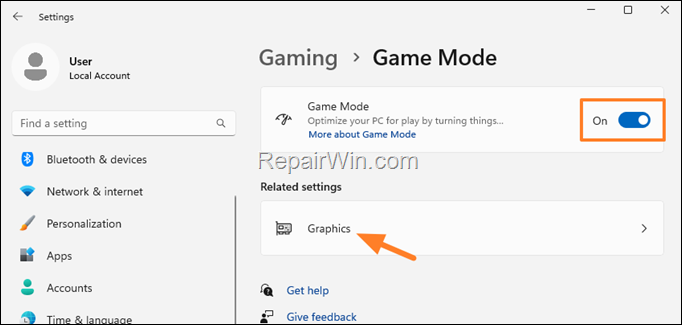

3. Then if you own Windows 11 click Change default graphics settings and set the “Reduce latency and use advanced features in compatible games…” switch to On. *
* Note: In Windows 10 this setting is named “Reduce Latency to improve performance…”
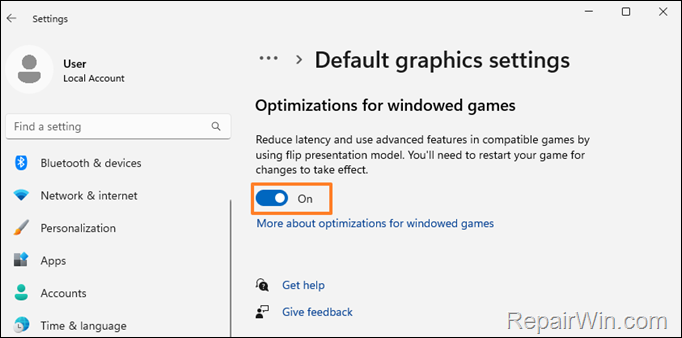

8. Adjust Game Settings.
Most games have their own settings to run better. So, search on the web to find out which are the best settings to optimize your gaming. In general, lowering in-game settings like resolution, graphics, and effects can also help improve performance.
9. Keep Windows Updated.
Always install the latest Windows updates to fix any operating system bugs and improve its performance. To keep Windows updated, go to Start > Settings > Windows Update and click Check for updates. Then if any updates found, proceed and install them.
10. Check your PC for Malware.
From time to time it is a good practice to check your computer for malware/viruses that affect its performance. For this task you can use the instructions on this guide: How to Scan and Clean your PC from Malware and Viruses.
How to Optimize your Hardware for Better Gaming Performance.
1. Clean your PC from Dust.
Make sure your computer is in a well-ventilated area and that no dust accumulates inside the case, which can block airflow. So, clean your computer from dust and make sure it doesn’t overheat, by measuring your system’s temperatures, e.g. by using the CPUID HWMonitor program.
2. Ensure Proper Cooling.
Gaming can be very demanding on your PC’s hardware, which can generate a lot of heat. Overheating can cause your PC to slow down or even shut down to prevent damage to the hardware.
To ensure your computer stays cool while gaming, make sure it is properly cooled and ventilated. Some ways to improve cooling are to add more fans or to use a liquid cooling system for your processor (CPU).
3. Upgrade Hardware.
As I mentioned above, one of the most important ways to optimize your PC for gaming is to ensure that your hardware meets at least the Minimum System Requirements for the game you want to play. But, even if your computer meets the minimum requirements, you can optimize your hardware to get the best possible performance by upgrading it to meet at least the recommended requirements.
a. Upgrade your Graphics Card.
One of the most important components for gaming is your graphics card. A high-quality graphics card can render complex graphics and animations quickly, which is essential for smooth gameplay. If your graphics card is outdated or underpowered, you may experience lag or choppy graphics, even if the rest of your PC meets the requirements for a game.
b. Increase your RAM.
Another important component for gaming is your RAM, or random access memory. RAM is used by your PC to temporary store data and instructions that are needed for running programs, including games. If you don’t have enough RAM, your PC may have to use virtual memory, which can slow down your system.
To increase your RAM, you’ll need to purchase additional RAM modules that are compatible with your PC’s motherboard. You can use a tool like Crucial® System Scanner to find out the type and size of RAM installed in your computer and if your motherboard supports more RAM.
c. Use an SSD for Storage.
An effective way to optimize your PC for gaming is to use an SSD (Solid State Drive), as your primary storage device for the operating system, applications and games. An SSD is much faster than a traditional hard drive (HDD), which can speed up load times for games and other applications.
d. Upgrade your Processor (CPU).
The CPU, or central processing unit, is the “brain” of your PC. It’s responsible for executing instructions and performing calculations for all of the programs and applications on your PC. If your CPU is outdated or underpowered, your PC may struggle to run games that require a lot of processing power.
To upgrade your CPU, you’ll need to find a compatible processor that is compatible with your PC’s motherboard. You can check your motherboard’s specifications to find out what kind of CPU your motherboard can support.
e. Get a Better Power Supply (PSU).
While many invest in a powerful processor and graphics card for their system, they neglect to invest in a high efficiency and reliable Power Supply Unit (PSU) and this is a mistake.
A high-quality PSU with enough power to cover the needs of the computer components, in addition to optimizing its performance, also protects the hardware components from damage.
Conclusion.
By optimizing Windows and upgrading your graphics card, increasing your RAM, and upgrading your processor, you can ensure that your PC is running at its best for gaming and applications.
That’s all! Please leave a comment in the comment section below or even better: like and share this blog post in the social networks to help spread the word about this solution.


